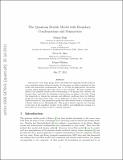The Quantum Double Model with Boundary: Condensations and Symmetries
Author(s)
Beigi, Salman; Shor, Peter W.; Whalen, Daniel
DownloadShor_The Quantum (arxiv).pdf (1.162Mb)
OPEN_ACCESS_POLICY
Open Access Policy
Creative Commons Attribution-Noncommercial-Share Alike
Terms of use
Metadata
Show full item recordAbstract
Associated to every finite group, Kitaev has defined the quantum double model for every orientable surface without boundary. In this paper, we define boundaries for this model and characterize condensations; that is, we find all quasi-particle excitations (anyons) which disappear when they move to the boundary. We then consider two phases of the quantum double model corresponding to two groups with a domain wall between them, and study the tunneling of anyons from one phase to the other. Using this framework we discuss the necessary and sufficient conditions when two different groups give the same anyon types. As an application we show that in the quantum double model for S 3 (the permutation group over three letters) there is a chargeon and a fluxion which are not distinguishable. This group is indeed a special case of groups of the form of the semidirect product of the additive and multiplicative groups of a finite field, for all of which we prove a similar symmetry.
Date issued
2011-06Department
Massachusetts Institute of Technology. Department of MathematicsJournal
Communications in Mathematical Physics
Publisher
Springer-Verlag
Citation
Beigi, Salman, Peter W. Shor, and Daniel Whalen. “The Quantum Double Model with Boundary: Condensations and Symmetries.” Communications in Mathematical Physics 306.3 (2011): 663–694. Web.
Version: Author's final manuscript
ISSN
0010-3616
1432-0916